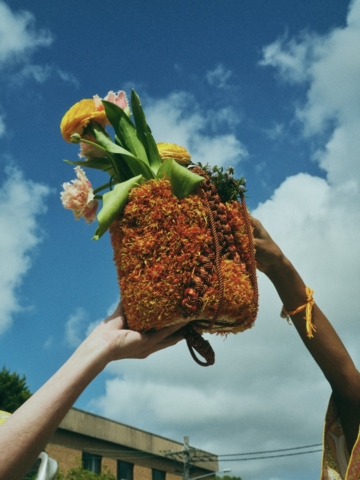Journeys of Colour and Texture
By Renee Umsted
As you are sitting on a beach, your feet bare, you feel the sand between your toes. Maybe it’s itchy and gritty, or maybe it’s soft and warmed from the sun’s rays on a long day in July. Looking to the sea, you notice the sky beginning to change, the bright light blues transforming into the rich oranges, golden yellows and intense fuchsias and reds before giving way to the thick darkness of a black night.
Colour and texture are incredibly powerful in evoking emotion and bringing about the recollection of memories, and that is why they are critically important in design, carefully considered and chosen, even though they may be unintentionally ignored. As nearly everything that exists is an example of design, it’s clear that colour and texture have a wide range of influence.
Since design has such a large presence in the world, it’s only natural that each year, a design week is held in Milan to celebrate it and the great minds who contribute to it. This April marked the 58th anniversary of the Salone del Mobile.Milano, which first started in 1961 to encourage exports of Italian furnishings and accessories.
One of the colourful products displayed at the event was from Reda Amalou Design. The Table Dot was inspired by traditional Japanese stools and is available in 23 shades. As subtle differences in colours can evoke entirely different feelings in the viewer, these pieces of furniture are carefully sanded after each of the at least 18 coats of pigment to produce the ideal finish. Though many of the colour options are monochromatic, they are not bland; rather, they exhibit a sense of depth, which is aided by the variety of colours available. From deep garnet to bohemian blue, the tables are capable of provoking a wide range of emotions and memories in people.
The tables are also made in two-tone lacquer and eggshell finishes, which are vastly different from the solid-coloured metallic, matte and glossy options. The brown and beige and seal brown two-toned tables almost resemble planks of wood or tree bark, with straight lines in neutral colours and varied thicknesses arranged in circular patterns encompassing the circumference of the tables. To make the eggshell tables as realistic and authentic as possible, the designer used real duck shells, which are cleaned, dried, broken up, sifted to find similar sizes, carefully placed on a glued surface and covered with at least 18 coats of lacquer, again sanded after each application. This type of intricate and skilled craftsmanship can only produce creations that are emotionally provocative.
Maarten de Ceulaer launched three projects at the design week, including the “Feathers” collection. Since the designer saw works by artists John James Audubon and John Gould, he has been using them as inspiration for his own creations; in addition to this, de Ceulaer has always been intrigued by birds, which are also the subjects of the artists’ pieces.
To create the rugs in the collection, de Ceulaer scans, isolates digitally and then combines feathers of different birds. Adjusting colours, shapes and textures, the designer artfully morphs the parts into an abstract grouping. What results is a compelling object that is transformed into a rug when Himalayan silk and wool are knit together by hand. With differing pile-heights, the piece is given dimension and definition as well as a distinct authenticity. In these rugs, texture is important in simulating the feeling of a bird’s feathers. Imagine sliding your foot over one of these rugs, the soft fabrics arranged in varying lengths, mocking the sensation of touching the delicate feathers of a beautiful bird. This is the result of good design: it can transport you, make you experience something you wouldn’t otherwise encounter.
And colour and texture do not necessarily have to transmit people to tangible places. For example, Marni’s exhibition at the Salone del Mobile is filled with neon and brightly coloured pieces that take the visitor on a sensory adventure to the world of Marni. Each piece was created with the help of Colombian artisans who have been working with the brand for years, and the blown glass pieces were formed to celebrate colour. It is difficult to pinpoint where exactly Marni’s showcase transports you, but the journey is undeniable.
In all of these examples, it is clear that colour and texture are not only relevant but intrinsic to design. They are capable of evoking feelings and memories in viewers and users, and though they may go unnoticed, to designers, they are two of the most critical aspects of design.







